1998 BUICK PARK AVENUE key
[x] Cancel search: keyPage 83 of 426
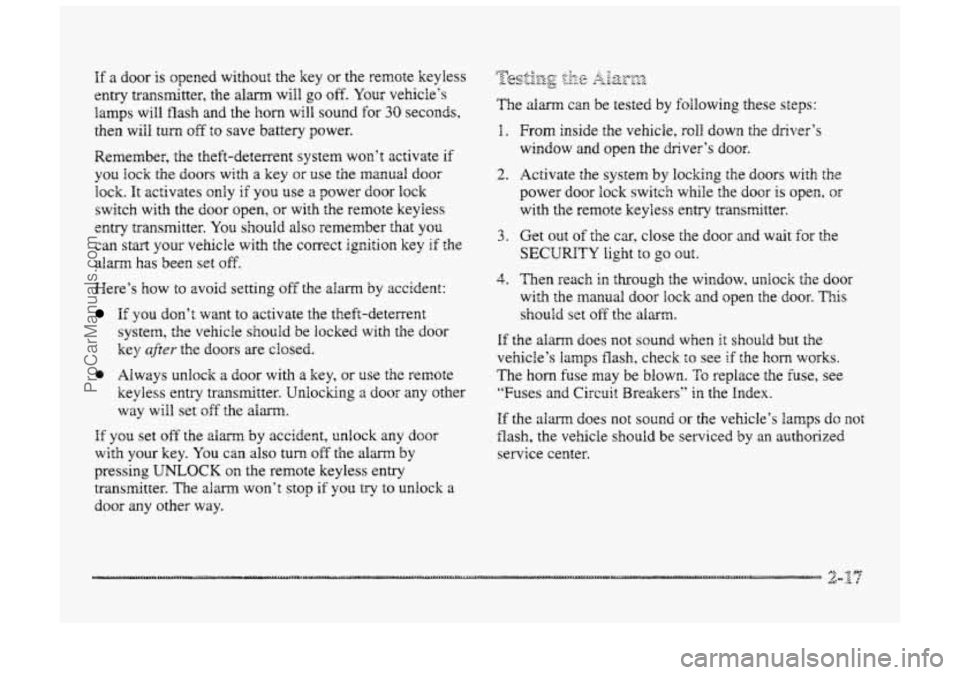
If a door is opened without the key OF the remote keyless
entry transmitter, the alm will
go off. Your vehicie‘s
lamps will flash and the
horn will sound for 30 seconds,
then
will turn of€ to save battery power.
Remember, the theft-deterrent system won’t activate if
you !ock the doors with a key or use the manual door
lock. kt activates only if you use a power door lock
switch with the
door open, or with the remote keyless
entry transmitter.
You should also remember that you
can start your vehicle with the correct ignition key if the
alm
has been set off.
Were’s how to avoid setting off the dam by accident:
I€ you don’t want to activate the theft-deterrent
system, the vehicle
should be locked with the door
key
after the doors are closed.
e Always U~IQC~ a door with a key, or use the remote
keyless entry transmitter. Unlocking
a door any other
way will set
of€ the alarm.
If you set off the alarm by accident, unlock any door
with your key. You can also turn off the alm by
pressing
UNLOCK on the remote keyless entry
transmitter. The
aim won’t stop if you try to unlock a
door any other way.
The aEm can be tested by following these steps:
1. From inside the vehicle, roll down foe driver’s
window and
open the driver’s door.
2. Activate the system by locking the doors with the
power
door lock switch while the door is open, or
with the remote keyless entry transmitter.
SECURITY light to go out.
3. Get out of the car, close the door and wait €or the
4. Then reach in through the window, unioclc the door
with the manual door lock and open the door. This
shouhd set off the altum.
If the alarm does not sound when it shdd but the
vehicle‘s
iiamps flash, check to see if the horn works.
The horn fuse may be blown. TQ replace the fuse, see
“Fuses and
Circrrit Breakers“ in the Index.
HE the alarm does not sound or the vehicle’s Bamps dc not
flash, the vehicle should be serviced by an authorized
service center.
ProCarManuals.com
Page 84 of 426
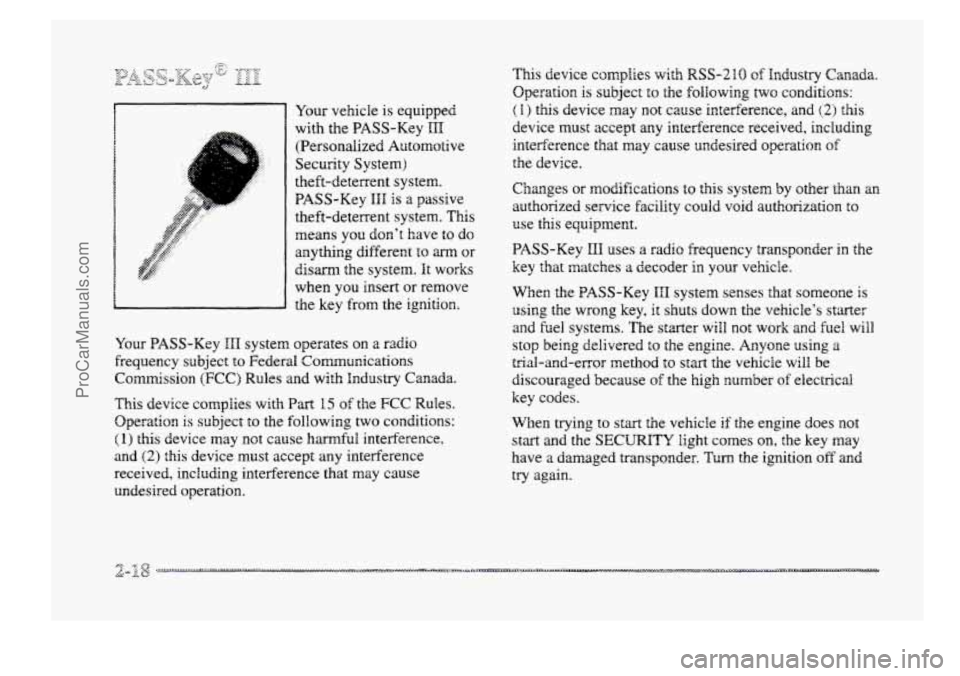
Your vehicle is equipped
with the PASS-Key
III
(Persondized Automotive
Security System)
theft-deterrent system.
PASS-Key
HHI is a passive
theft-deterrent system.
This
means you don’t have to do
anything different to arm or
disarm the system. It works
when YOU insert or remove
the key
from the ignition.
Your PASS-Key
III system operates on a radio
frequency
subject to Federal Communications
Commission
(FCC) Rules and with Industry Canada.
This device complies
with Part 15 of the FCC Rules.
Operation
is subject to the following two conditions:
(I) this device may not cause harmful interference,
and
(2) this device must accept any interference
received, including interference that may cause
undesired operation.
This device complies with RSS-210 of Industry Canada.
Operation
is subject to the following two conditions:
(I) this device may not cause interference, and (2) this
device must accept any interference received, including
interference that may cause undesired operation
of
the device.
Changes
or modifications to this system by other than an
authorized service facility could void authorization to
use this equipment.
PASS-Key
HI1 uses a radio frequency transponder in the
key that matches a decoder in your vehicle.
When the PASS-Key
III system senses that someone is
using the wrong key, it shuts
down the vehicle’s starter
and fuel systems.
The starter will not work and he8 will
stop being delivered to the engine. Anyone using a
trial-and-error method to start the vehicle will be
discouraged because
of the high number of electrical
key codes.
When trying
to start the vehicle if the engine does not
start and the SECURITY light comes on, the key may
have
a damaged transponder. Turn the ignition off and
try again.
ProCarManuals.com
Page 85 of 426

If the engine still does not start, and the key appears to
be undamaged, try mother ignition key. At this time,
you may also want to check the fuse (see “Fuses and
Circuit Breakers’‘
in the Index). If the engine still does
not start with the other key, your vehicle needs service.
If your vehicle does start, the €kt key may be faulty.
See your dealer or a
Iocksrnith who can service the
PASS-Key
IIH tc have a new key Bade.
It is possible for the PASS-Key IIP decoder to learn the
transponder value
of a new replacement key. Up to
ten additional keys may be programmed for the vehicle.
This procedure is €or learning additional keys only. If all
the currently programed keys are lost or do not
operate, you must see your dealer or a locksmith who
can service PASS-Key
HI1 to have keys made and
programmed
to the system.
See your dealer or 2 locksmith who can service
PASS-Key
III to get 2 new key blank that is a cut
exactly
as a current black colored driver’s key that
operztes the system.
Do not use 2 gray colored valet key
for this procedure.
To program the new key:
1.
2.
3.
4.
5.
Insert the cumrent driver’s key (black in color) i~* the
ignition
and start the engine. If the engine wiil not
start see your dealer for service.
After the engine has started,
turn the key to the off
position, and remove the key.
Insert the key
to be progrmmed and turn it to the
mn position within ten seconds of removing the
previous key.
The
SECURITY telltale iight will off once the
key
has been programmed. It may not be apparent
that the SECURITY light went on due to how
quickly
the key is programmed.
Repeat steps
1 through 4 if additional keys are to
be programmed.
ff you are ever driving and the SECURITY iight comes
or; and stays on, you will be able to restart your engine if
you turn it off. Your BASS-Key III system, however, is
not working properly and must be serviced by your
dealer.
You vehicle is not protected by the PASS-Key
III system at this time.
If you lose or damage a PASS-Key I11 key, see your
dealer or a locksmith who can service PASS-Key HIT to
have a new key made.
ProCarManuals.com
Page 86 of 426
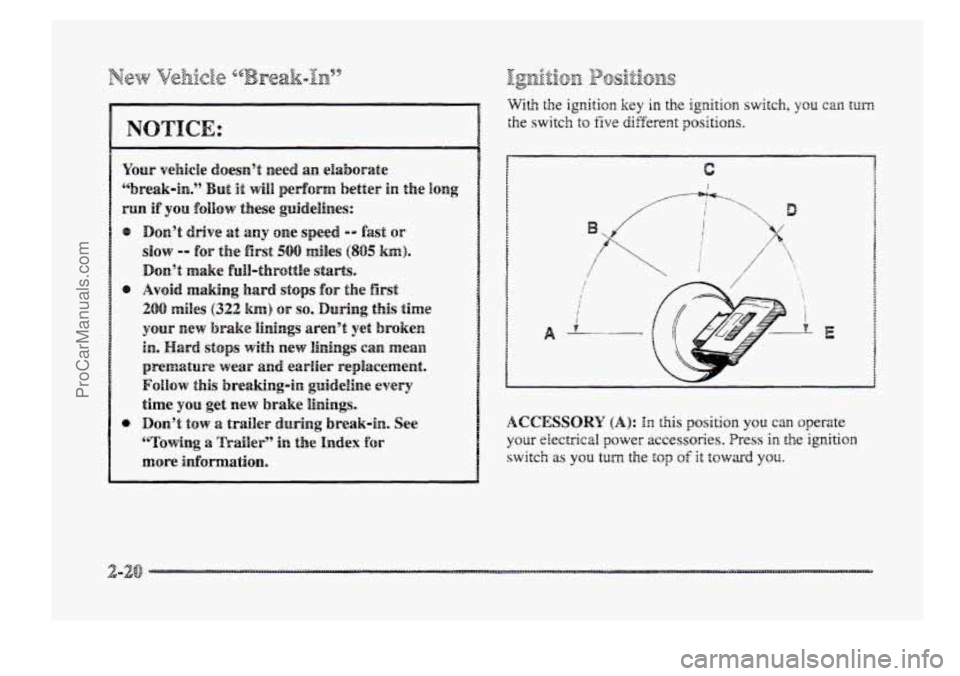
NOTICE:
0
With the ignition key in the ignition switch, you can turn
the switch to five different positions.
A
I
I i v
i
2- E
ACCESSORY (A): In this position you can operate
your eiectricall power accessories. Press in the ignition
switch as you turn the top of it toward you.
ProCarManuals.com
Page 87 of 426
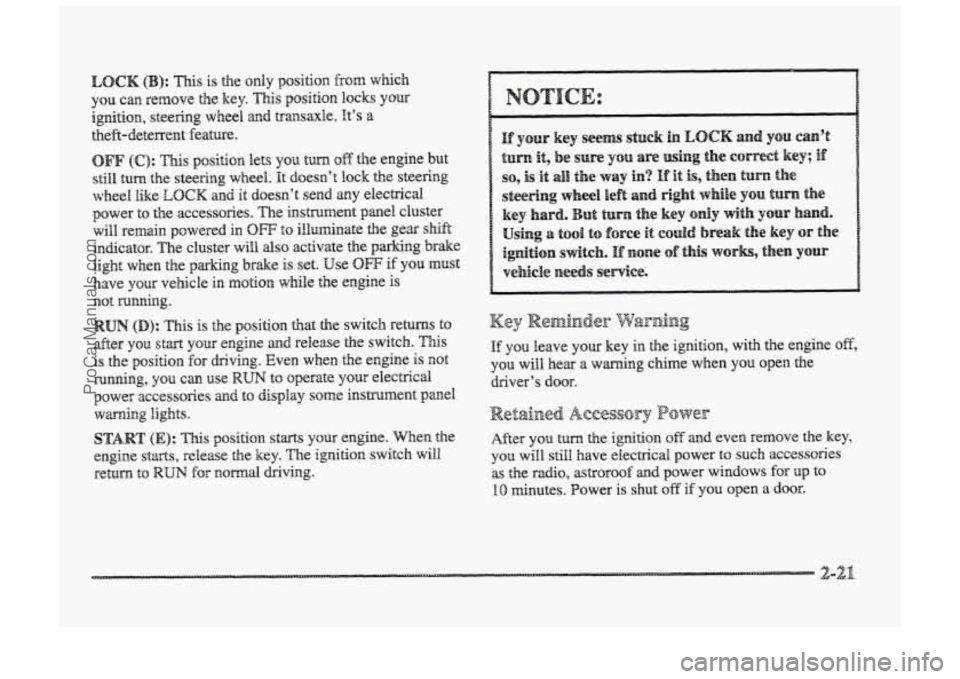
I
LOCK @I: This is the only position from which
YOU can remove the key. This position locks YOU
igition, steering wheel and transaxle. It’s a
theft-deterrent feature.
OFF (C): This position lets YOU turn ofif the engine but
still turn the steering wheel. It doesn’t lock the steering
wrlhee1 like LOCK and it doesn’t send my electrical
power to
the accessories. The instrument panel cluster
will remain powered in OFF to illarminate the gear sWt
indicator. The cluster will also activate the parking brake
fight when the parking brake is set. Use OW if you must
have your vehicle in motion while the engine is
not mnanaing.
RUN (D): This is the position that the switch returns to
after you start YSUP engine and release the switch. This
is &e p~sisi~n for driving. Even when the engine is not
running, you can use RUN to operate your electrical
power accessories anad t~ display some instrument panel
START (E): This position starts your engine. When the
engine
starts, release the key. The ignition switch will
return to RUN for ~a~rrrnal driving.
wdng
lights.
Retained Acces§ory Power
After you turn the ignition off md even remove the key,
you
will still have electrical power to such accessories
as the radio, astroroof ad power windows for up to
10 minutes. Power is shut off if you open a door.
2-21
ProCarManuals.com
Page 88 of 426
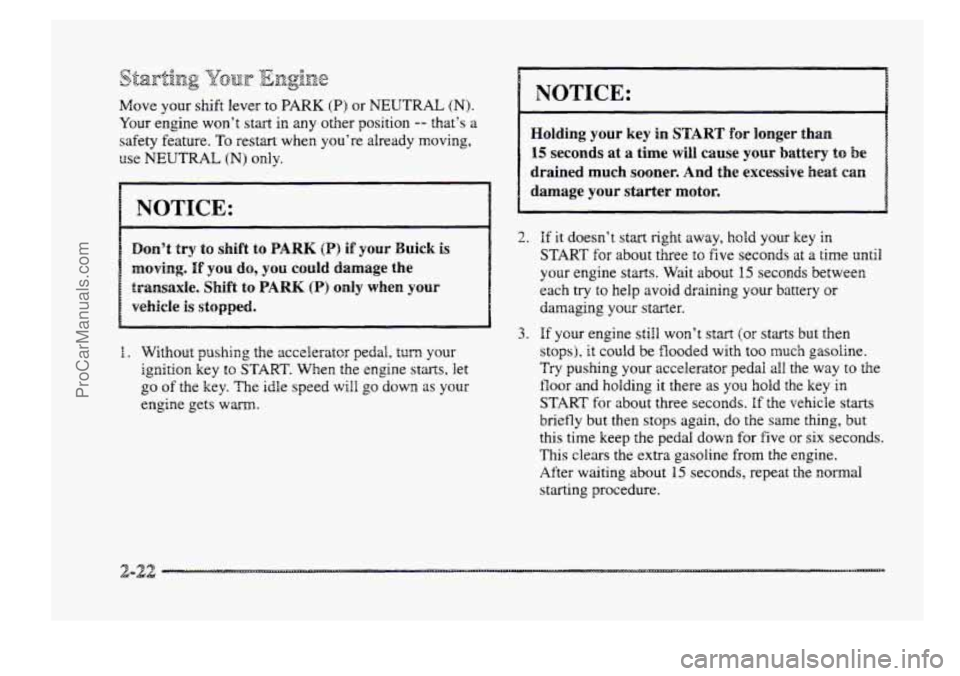
Move your shift lever to BARK (B) or NEUTRAL (N).
Your engine won’t start in any other position -- that’s a
safety feature. To restart when you’re already moving,
use NEUTRAL (N) only.
1 NOTICE:
Don9t try to shift to PARK (a) if your hick is
moving. If YOU do, YOU could damage the
transaxle.
Shift to PARK (P) only when your
vehicfe is stopped.
8. Without pushing the accelerator pedal, turn your
ignition key to START. When the engine starts, let
go
of the key. The idle speed will go down as your
engine gets wann.
NOTICE:
Holding your key in START €or longer than
15 seconds at a time will cause your battery to be
drained much sooner.
And the excessive heat can
damage your starter motor.
2. if it doesn’t start right away, hold your key in
START for about three to five seconds at a time until
your engine starts. Wait about 15 seconds between
each
try to help avoid draining your battery or
damaging your starter.
3. If your engine still won’t start (or starts but then
stops), it could be flooded with too much gasoline.
Try pushing your accelerator pedal
all the way to the
floor
and holding it there as you hold the key in
START for about three seconds. If the vehicle starts
briefly but then stops again, do the same thing, but
this time keep the pedal down for five or
six seconds.
This clears the extra gasoline from the engine.
After waiting
about 15 seconds, repeat the normal
starting procedure.
ProCarManuals.com
Page 91 of 426
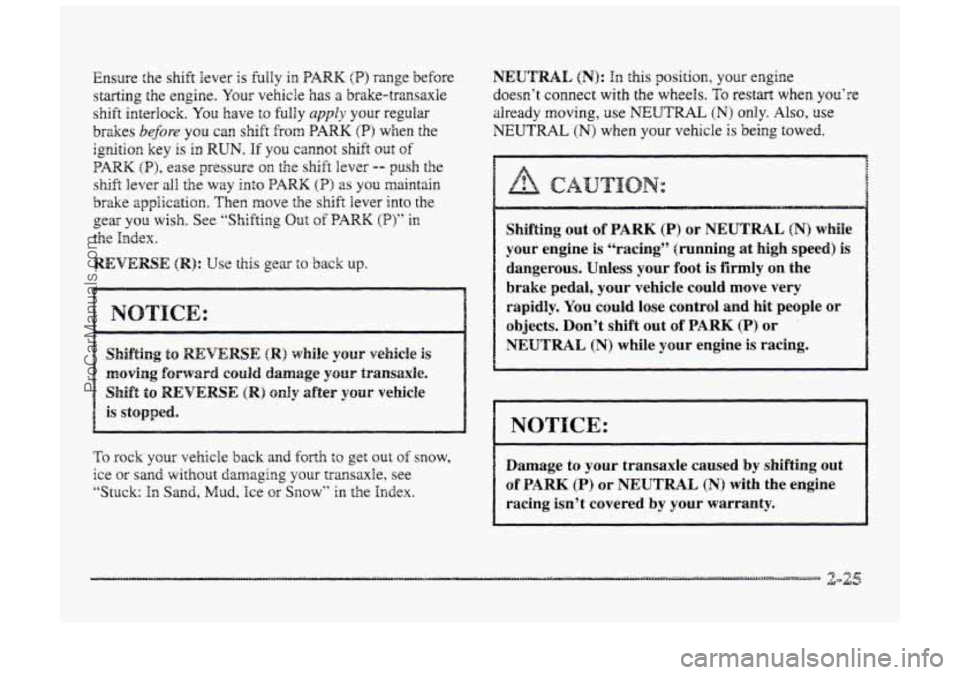
Ensure the shift lever is fuily in PARK (PI range before
starting the engine.
Your vehicle has a brake-transaxle
shift interlock.
You have to fully apply your regular
brzkes
before you can shift from PARK (P) when the
ignition key is in RUN. If you cannot shift out of
PARK (B), ease pressure on the shift lever -- push the
shift lever all the way into PARK (P) as you rnaintain
brake appiic~tion. Then move the shift lever into the
gear you wish. See “Shifting Out of PARK (E’)” in
the Index.
REVERSE (R): Use this gear to back up.
Shift to REVERSE (R) oanhy after vehicle
To rock your vehicle back and forth to get out of snow,
ice sand without damaging your transaxle, see
“Stuck:
In Sand, Mud, Ice or Snow” in the Index.
NEUTRAL (N): In this position, your engim
doesn’t connect with the wheels.
To restart when you’re
already
moving, use NEUTRAL (N) only. Also, use
NEUTRAL (N) when your vehicle is being towed.
Shifting out of PARK (P) or NEUTRAL fN) while
your engine is “racing” (running
at high speed) is
dangerous. Unless your foot is firmly on the
brake pedal, your vehicle could move very
rapidly. You could lose control and hit people
or
objects. Don’t shift out of PARK (P) or
NEUTRAL (N) while your engine is racing.
1 NOTICE:
Damage to your transaxle caused by shifting out
of PARK (P) or NEUTRAL (N) with the engine
racing isn’t covered by your warranty.
ProCarManuals.com
Page 93 of 426
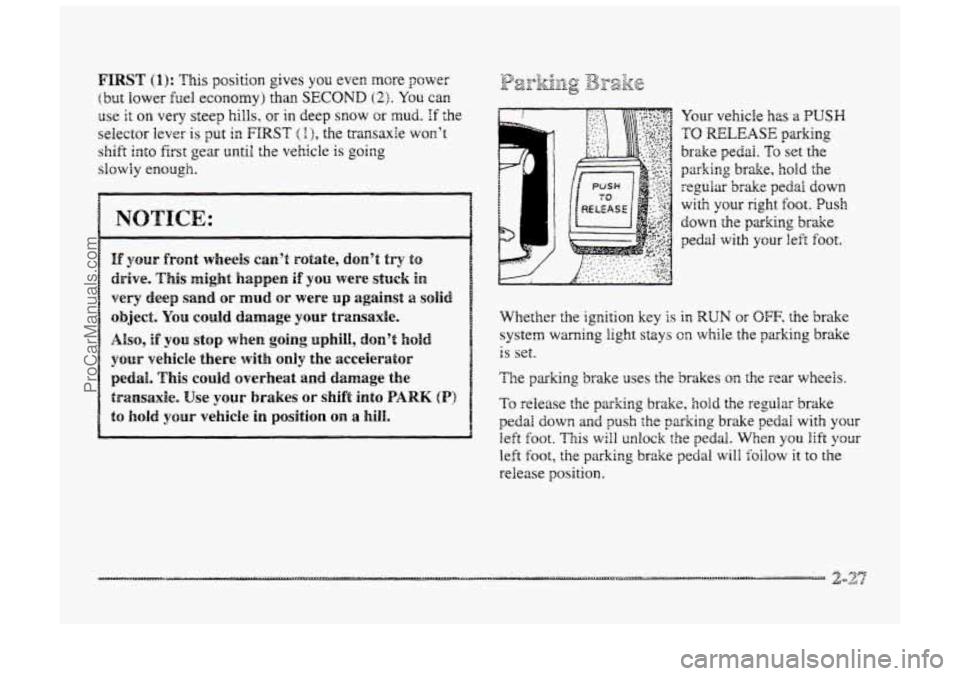
FIRST (I): This position gives you even more power
(but lower fuel economy) than SECOND (2). You can
use it on very steep hills, or in deep snow or mud. If the
selector lever is put in FIRST ( I >, the transaxle won’t
shift into first gear until the vehicle is going
slowHy enough.
If your hplrt wheels can’t rotate, don’t try to
drive. This might happen if YOU were stuck in
very deep sand OF mud or were up against a solid
object. You could damage your transaxle.
Also, if you stop when going uphill, don’t hold
your vehicIe there with only the accelerator
pedal. This could overheat and damage the
transaxle. Use ysur brakes or shift into BARK (P)
Your vehicle has a PUSH
TO RELEASE parking
brake pedai. To set the
parking brake, hold the
regular brake pedal down
with your right foot. Push
down the papking brake
pedal with your left foot.
~~ ~~
Whether the ignition key is in RUN or OFF. the brake
system
wming light stays on while the parking brake
1s set.
The parhng brake uses the brakes the rear wheels.
To release the parking brake, hoki the regular brake
pedal down and push the parking brake pedal with your
left foot. This will unlock the pedal. When you lift your
left foot, the parking brzke pedal will foilow it to the
release position.
ProCarManuals.com